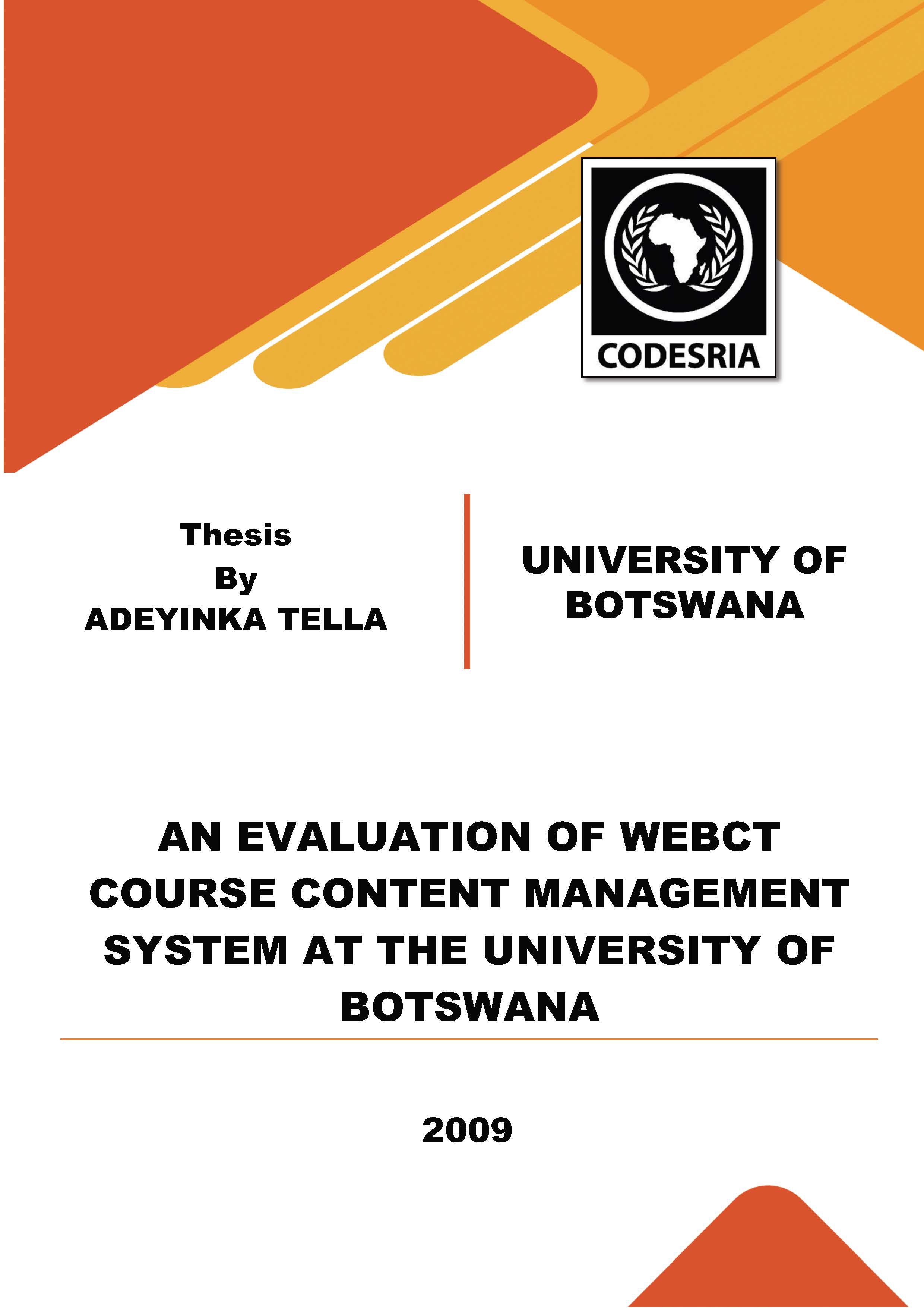AN EVALUATION OF WEBCT COURSE CONTENT MANAGEMENT SYSTEM AT THE UNIVERSITY OF BOTSWANA
Keywords:
WEBCT, MANAGEMENT, UNIVERSITY OF BOTSWANASynopsis
This study was conducted to evaluate WebCT course co~tent management system (CCMS) at the University of Botswana from the perspective of perceptions of students and academic staff. The survey methodology was use. d and questionnair. es were distributed to 503 students selected fro. m six faculties. An in-depth interview was also conducted involving (20) twenty lecturers who teach via WebCT platform. The data collected through a questionnaire was analysed using the statistical Package for Social Sciences (SPSS) to generate percentages and frequency count, Pearson Multiple Correlation, Analysis of variance and Stepwise Multiple Regression; while qualitative data was analysed using (content analysis), and thematic categorisation.
The findings on the perceptions of students and staff suggest generally that WebCT CCMS at the University of Botswana has been reasonably successful. The findings also suggest that the quality of course materials uploaded on the system, service quality, the quality of the teaching and learning via the system are generally acceptable. By learning through WebCT students are able to self regulate their learning and that given an opportunity they are ready to use and continue learning using the WebCT. platform. The results also suggest that generally students are satisfied with the performance of WebCT and there are many benefits associated with the system as far as teaching and learning at the university is concerned.
Moreover, the results of the tested hypotheses suggest that all the identified factors or measures (system quality, content quality, service quality, teaching and learning quality, student self-regulated learning, intention to use/ use, user satisfaction and net benefits) are good determinants of WebCT CCMS success. The study proposes CCMS success evaluation model that could be used in the evaluation of any e-learning course content management system. The model is based on the modified Delone and Mclean (2003) IS model. The proposed model outlines eight factors or measures that should be used in the assessment and evaluation of an e-learning system.
The problems associated with WebCT CCMS that are experienced by both the staff and students of the University include access, network /server failure, lack of a link between the administrative system integrated technology service (ITS) and Web based communication tool WebCT, lack of expertise to teach using WebCT on the part of the lecturers, failure to remove completed courses from the system, and others.
The respondents suggest that there is need for the university to consider constructing more computer labs on the campus and provide more computers, train and induct both lecturers and students on how to use WebCT for tea~hing and learning purposes, make use of WebCT at us· compulsory. and improve bandwidth.
The study concludes by making several recommendations concerning the improvement in the use of WebCT at the University of Botswana. Further areas of research were recommended that include:
• Investigating the causal relationship between e-learning/WebCT CCMS success factors,
• Examining the attitude of non-users of WebCT CCMS at the University of Botswana,
• Impact of WebCT on leaning achievement,
• Cost-benefit analysis of WebCT usage at UB .
Downloads
References
Burrel, G. & Morgan, G. (1979). Sociological paradigms and organizational analysis: Elements of the sociology of corporate life. Ashgate Publishers.
Buyukkurt, M. D. & Vass, E. C. (1993). Investigation of factors contributing to satisfaction with end-user computing process. Canadian Journal of Administration Sciences 10 (3), 212-228.
Campbell, D. R. & Fiske, D. W. (1959). Convergent and discriminant validation by multitrait-multimethod matrix. Psychological Bulletin 56 (2), 81-105.
Cao, M. Zhang, Q. & Seydel, J. (2005). B2C e-commerce web site quality: an empirical examination. Industrial Management & Data Systems 105 (5), 645-661.
Carliner, S. (2005). CMSs versus LMSs. Available:ASTD Worldplacelearning & Performance Website: http:www.astd.org [25 February 2008].
Caruso, B. J. (2006). Measuring student experiences with course management systems (EDUCAUSE Research Bulletin, 19). Available: http:llwww.educause.edu1LibraryDetailPagel666?1D=ERB0619 [accessed 14 December 2006].
Center for Academic Development. (CAD). University of Botswana. (2007). UB e-Jearning statistics and outcome from semester 1, 2002- semester 2, 2007. University of Botswana, Gaborone.
Chandler, J. (1982). A Multiple Criteria Approach for Evaluating Information Systems. MIS Quarterly (6:1), 61-84.
Chickering, A. W. & Gamson, Z. F. (1987). Seven principles for good practice. AAHE Bulletin, 39, 3-7.
Chien, S. W. & Tsaur, S.M. (2007). Investigating the success of ERP system: Case studies in three Taiwanese high-tech industries. Computer in Industry 58 (8-9), 783-793.






